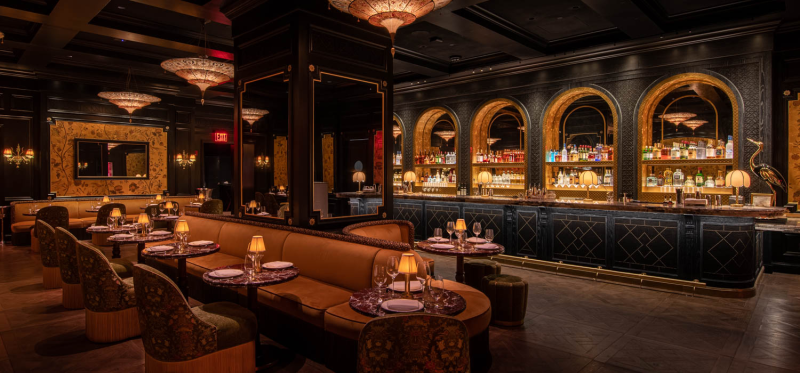Contents
- 1 How Brett Andersen Raises The Bar In Lighting Design
- 1.1 Interior Design: Our relationship with light changed dramatically after the pandemic, taking into account its impact on mental health. Could you talk about this shift?
- 1.2 ID: Mood lighting, especially in the U.S., seems to take priority over overhead lighting now. Have you noticed the same?
- 1.3 ID: Early on, you worked on stage lighting for theater. What similarities do you see between stage lighting and architectural interiors?
- 1.4 ID: Visiting Tivoli Gardens in Copenhagen at night as a teenager ignited your interest in lightning, and years later, you designed lighting for the theme park. How do you maintain a childlike whimsy and enthusiasm in your work?
- 1.5 ID: How do you balance a sense of warmth with high-end luxury at a restaurant project like Sartiano’s?
- 1.6 ID: The Cathédrale project in Las Vegas seems to pay homage to your interest in stage lighting. Could you talk about your vision for this space?
- 1.7 ID: You collaborated with Ken Fulk for Crown Club. How did you bring to life a collaborative vision that reflects the venue’s association with entertainment while also conveying elegance?
- 1.8 ID: PleasureMed seems to nod to traditional apothecaries with its ornate wood-heavy interior. What was the brief in this project and what was your strategy to secure the intended impact?
- 1.9 ID: For the lower level of the dispensary, you intended to switch from sunlight to candlelight. What does this transition of light mean for you?
- 1.10 ID: How do you approach leadership at Focus Lighting? How has your teamwork evolved since the pandemic?
Crown Club. Brooklyn, NY. Photography by Ryan Fischer.
Lighting designer Brett Andersen is among the most sought-after conductors of light in the U.S. He and his team at Harlem-based Focus Lighting illuminate some of the buzziest venues around New York City, including the Mercer Hotel’s Sartiano’s restaurant in SoHo and Barclay Center’s exclusive Crown Club in Brooklyn. He also had a hand in the dramatically-designed entertainment venue Cathédrale in Las Vegas and worked on the recent design of West Hollywood cannabis shop PleasureMed.
Andersen believes his growing profile of ambitious projects stems from a collaborative soul, whether this means touching base his team at Focus Lighting on a daily basis or joining forces with design authorities, such as Ken Fulk. “I’m really proud of our collaborative environment at Focus,” he says. “We always say ‘the best idea rises to the top,’ no matter who it comes from.”
New York is a major inspiration for the designer who cut his teeth in stage design before transitioning to interiors. “Broadway shows, amazing museum exhibits, great hotels and restaurants, as well as one of the best lit skylines in the world are all fuel for the creative work we do,” he adds. “The bar is constantly being raised which inspires us to produce our very best work.”
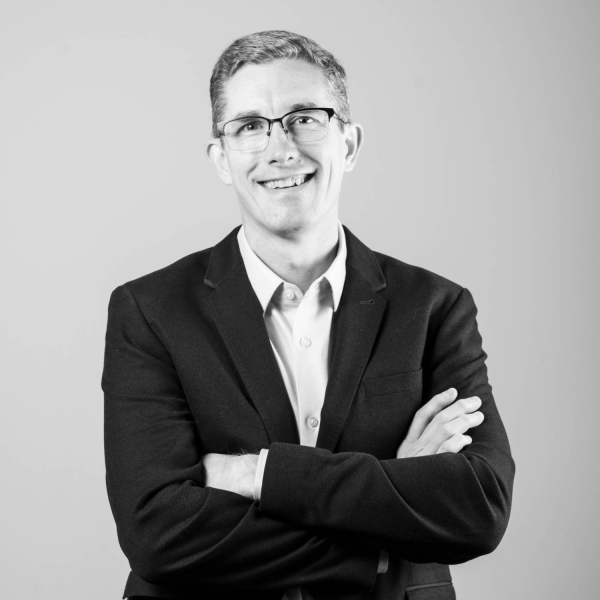
Brett Andersen. Photography courtesy of Brett Andersen.
How Brett Andersen Raises The Bar In Lighting Design
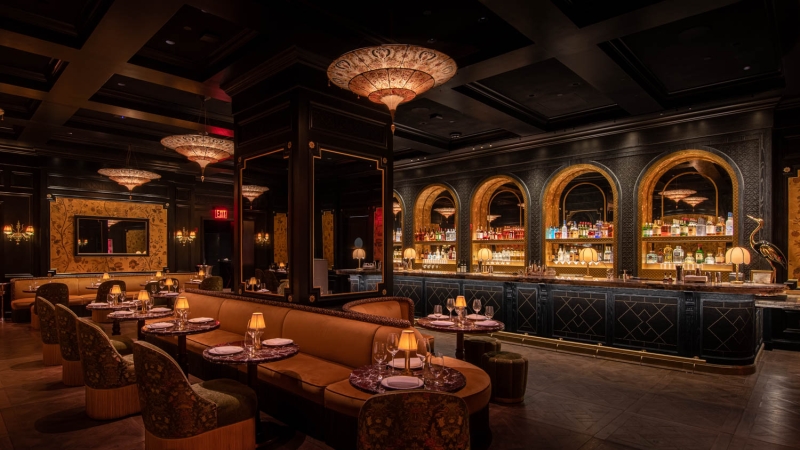
Crown Club in Brooklyn, New York. Photography by Ryan Fischer.
Interior Design: Our relationship with light changed dramatically after the pandemic, taking into account its impact on mental health. Could you talk about this shift?
Brett Andersen: During the pandemic, many of us threw off our circadian rhythm, either by never going outside for that daily dose of blue light, or by doom-scrolling on our phones into the wee hours of the night, when our bodies were expecting to experience warmer sources of light. This disruption greatly upset not only our sleep cycles, but also our overall mental health. Thankfully, most have recovered from this disturbance, and luckily there is now a much deeper understanding and appreciation by the general public of just how connected we all are to the lighting we experience every day.
ID: Mood lighting, especially in the U.S., seems to take priority over overhead lighting now. Have you noticed the same?
BA: Yes, very much so. Years ago, residential lighting for most homes was pretty simple: a 60 watt or 100 watt incandescent bulb you picked up at the grocery store did most of the work. Usually, they were controlled by a wall switch or maybe a dimmer. Today, there are a lot more options. Just visit the lighting aisle at your local Home Depot, and you’ll find hundreds of different LED bulbs you can buy. This has forced people to become more knowledgeable about the different qualities of light, like color temperature, color-rendering, and dimmability—usually through trial and error.
But the explosion of LED technology has also allowed the public to act as their own lighting designer. Now, you can buy LED bulbs that change to any color, easily controlled wirelessly via an app on your phone. Within a few minutes time, you can create multiple lighting scenes for your home—completely changing the mood—just like a lighting designer does for a restaurant or hotel. It’s so exciting to see more and more people experience and appreciate the power light can have firsthand.
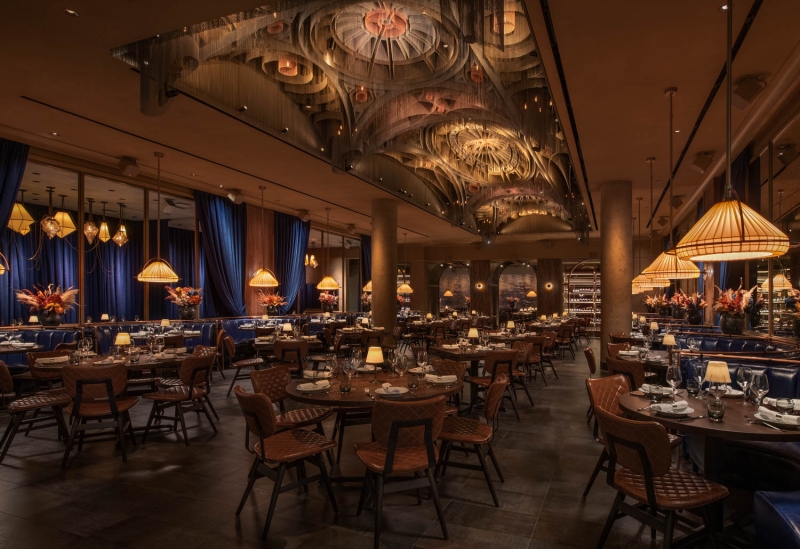
Cathédrale in Las Vegas, Nevada. Photography by TAO Group.
ID: Early on, you worked on stage lighting for theater. What similarities do you see between stage lighting and architectural interiors?
BA: When I made the move from theatrical to architectural lighting design, I was surprised how similar they were. Certainly, the types of light fixtures we use for architecture are often different, but how we think about and use light is the same. Of course, we need to provide the needed illumination to safely move around and allow people to do the required tasks within a space. But that’s really our most basic responsibility as a lighting designer. Our larger contribution is helping the interior designer and architect tell the story of their space, often by combining their chosen materials, colors, and textures with layers of light in varying intensities and tints of color to create the most pleasing visual composition. Just like a theatrical designer, we use light to guide the eye to the most important elements within a space and hopefully stir an emotional response, making the experience all the more memorable.
ID: Visiting Tivoli Gardens in Copenhagen at night as a teenager ignited your interest in lightning, and years later, you designed lighting for the theme park. How do you maintain a childlike whimsy and enthusiasm in your work?
BA: I’m constantly telling our designers they need to make time to “Play with light.” For us, the act of shining a light fixture at a surface and seeing how the perception of that surface changes depending on the angle, color, or brightness of the light is a magical experience. To help facilitate this, we have a space in our Harlem studio we call our Lighting Lab. This is where we go to play with light every day. Not only do we use it to test or show our ideas, but it’s also inherently connected to our creative process. The space allows us to experiment and iterate on our design ideas, often in unexpected and surprising ways. This is one of the reasons I still love working with light, all these years later.
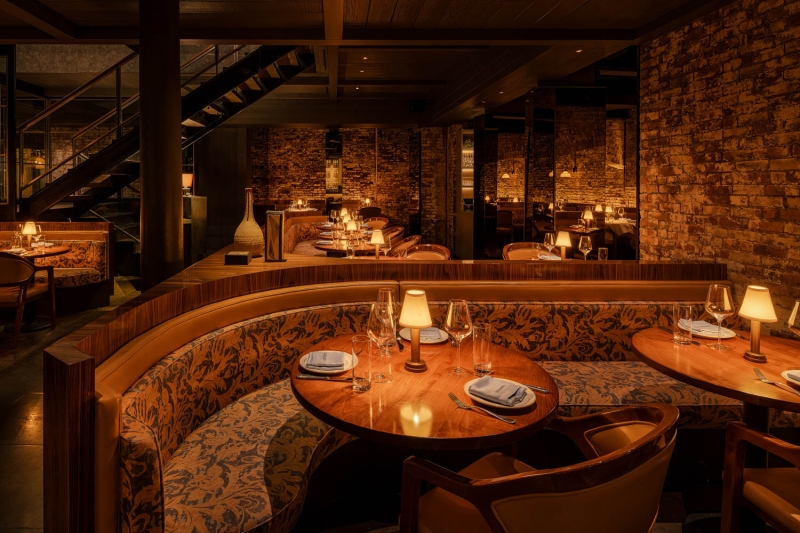
Sartiano’s in New York, New York. Photography by Ryan Fischer.
ID: How do you balance a sense of warmth with high-end luxury at a restaurant project like Sartiano’s?
BA: Sartiano’s was an interesting challenge. How do you make a space feel cozy and inviting from the moment you walk in, but also have the allure of exclusivity that makes you feel fortunate to be experiencing it?
To start, the subterranean nature of the architecture makes it feel like you’re descending into a secretive, hidden experience. And because there are no windows, no one on the street can see who’s dining, further adding to the exclusive feeling. For the lighting though, we knew we didn’t want the space to feel cave-like. The walls needed to be softly, and warmly uplit, and each table needed to be its own destination which we accomplished through a small LED table lamp that provides just enough light on the food and guest’s faces to create a sense of intimacy.
ID: The Cathédrale project in Las Vegas seems to pay homage to your interest in stage lighting. Could you talk about your vision for this space?
BA: When you walk into the main dining room at Cathédrale, one of the first things you’ll notice is the stunning display of thousands of bead chains in copper, bronze, and silver. Our goal was to highlight that feature as a dramatic focal point, just as we would a piece of scenery on a stage. We worked alongside contractors and designers to install light fixtures that were precisely positioned to create the perfect sense of synergy between both the sculpture and the lighting.
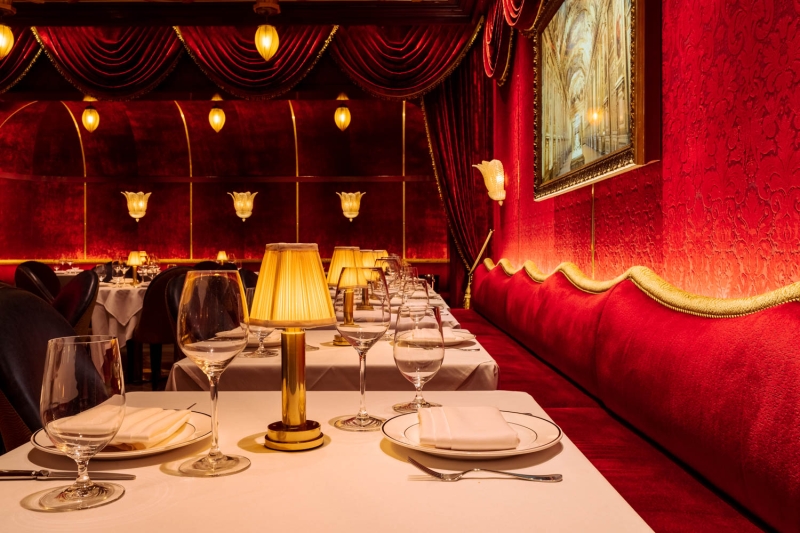
Crown Club in Brooklyn, New York. Photography by Ryan Fischer.
ID: You collaborated with Ken Fulk for Crown Club. How did you bring to life a collaborative vision that reflects the venue’s association with entertainment while also conveying elegance?
BA: Ken’s design for Crown Club is an incredible juxtaposition: an elegant and exclusive experience tucked away within a 20,000 seat arena. When guests step away from their seats, they’re escorted to a gold door. Beyond, they are transported to another time and an entirely different place. The richness of the colors and textures creates a luxurious environment where guests can enjoy elevated food and drinks in a lounge that offers a welcome reprieve from the hustle of the game just outside. The goal of our design was to ensure the patrons could see and appreciate all that richness in Ken’s design. In the dining room, for example, we spent hours making sure the pleating of the fabric was just right so that the accent lighting could capture all the opulence of the drapery. In the pantry, we mocked up the lighting to guarantee the paint choice for the shelving was vibrant without overpowering the curated snack collection once our lighting was integrated. Because lighting is often what brings a space to life, it’s important we view the room and the materials holistically, so we truly understand what the experience will be from the patron’s point of view.
ID: PleasureMed seems to nod to traditional apothecaries with its ornate wood-heavy interior. What was the brief in this project and what was your strategy to secure the intended impact?
BA: For PleasureMed, we wanted to create an unexpected environment, a more inviting and memorable experience than your typical cannabis dispensary. Inspired by a 1950s Cuban apothecary, our goal was to use light to help transport patrons to this vibrant and playful destination. One of the ways we did this was to use small and inexpensive LED lights located in each of the many planters, highlighting the green foliage and projecting dramatic shadows on to the ceiling above, and subtly reminding guests of the space’s tropical theme.
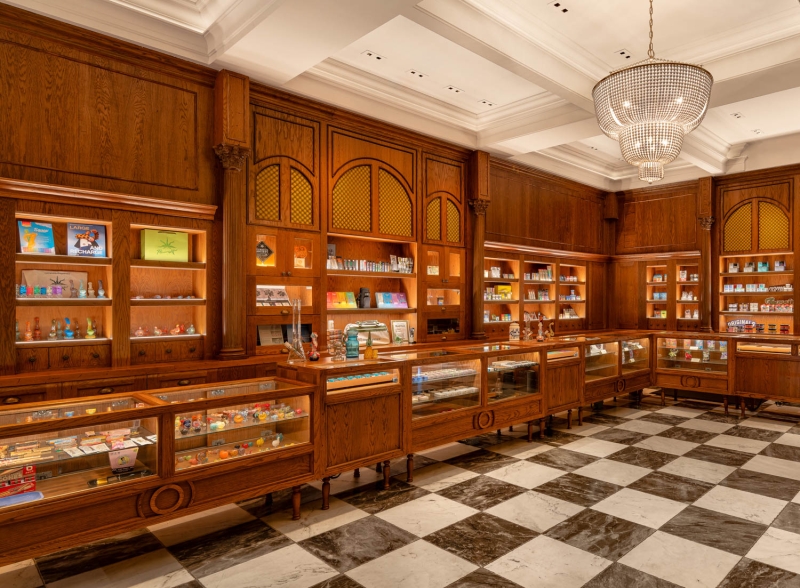
PleasureMed in West Hollywood, California. Photography by Ryan Fischer.
ID: For the lower level of the dispensary, you intended to switch from sunlight to candlelight. What does this transition of light mean for you?
BA: We knew that during the day, the sunlight would fill the space with cooler-colored, natural light. But at night, we wanted to shift to that familiar and comfortable glow. Thanks to LED warm-dim technology that mimics the characteristics of an incandescent bulb, we were able to use cooler, brighter light during the day, and then dim the lighting at night, warming up the space, all from the same LED fixture. It’s in that soft, warm light that patrons look and feel their best.
ID: How do you approach leadership at Focus Lighting? How has your teamwork evolved since the pandemic?
BA: We push our designers to contribute their ideas and points of view, and I believe that’s what keeps our lighting ideas fresh and innovative. Designing lighting during the pandemic was a challenge. While collaboration was possible over Zoom, not being able to come into the office to experiment with light meant we were forced to do our mock-ups in our bathrooms or garages at home.
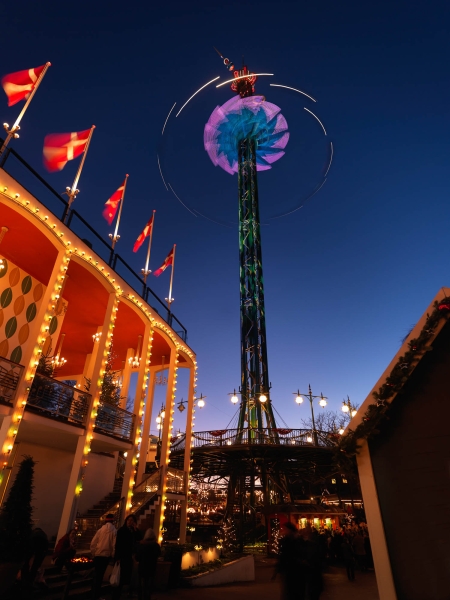
Tivoli Gardens in Copenhagen, Denmark. Photography by Allan Toft.
